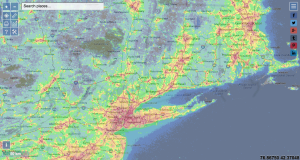
An Astronomer’s View of Street Lighting
By Lawrence L. Faltz MD, President, Westchester Amateur Astronomers
When the Northridge earthquake cut power in Los Angeles in January 1994, the Griffith Observatory received phone calls from concerned citizens asking about a mysterious cloud overhead that they had never seen before. The Milky Way, our galaxy, had probably not been visible from downtown LA for half a century.
It’s estimated that more than two-thirds of the people in the world cannot see the Milky Way from their homes. We light up our environment for safety, to allow us to move about at night, and to decorate our homes and businesses. But this light is also obliterating the stars–a source of inspiration and information for diverse cultures across the centuries.
Light pollution doesn’t just wash out the glories of the night sky and frustrate amateur astronomers. It wastes energy and money. Poor lighting design creates glare that actually makes it difficult to see well at night. Misdirected light crosses property lines and intrudes into homes, disturbing sleep. Hundreds of studies have documented the adverse effects of light pollution on the environment. It has devastating impact on some animal behaviors. More than 1,600 investigations into its impact on human health have been published. It may be a carcinogen. The American Medical Association is sufficiently concerned to have voted to “support light pollution reduction efforts and glare reduction efforts” and to “support efforts to ensure all future streetlights be of a fully shielded design or similar non-glare design to improve the safety of our roadways.”

Municipalities all over the United States, including towns in Westchester, are replacing their older streetlights with brighter LED streetlamps. The main reason is economic: LED streetlamps use much less power and have very long lives, reducing costs. New York City is replacing a quarter of a million street lamps and each year expects to save $6 million in energy costs and $8 million in maintenance. Another positive factor is that these fixtures are better shielded than the old “cobra head” sodium vapor lamps, projecting more of the light where it’s needed and not uselessly up to the sky. However, while shielding is better than before, it’s not as good as it could be. New York City’s LED streetlamps still project 5% of the light upward and up to 20% into the “glare zone” at or above 80 degrees. Many municipalities are installing similar “semi-cutoff” street lamps.
In addition, most of the fixtures installed to date use LED’s that emit light that is enriched in the blue part of the spectrum. Blue-rich LEDs produce three times as much skyglow as the older lights because blue light scatters much more efficiently than light in the “warmer” (yellow) part of the spectrum, a phenomenon known as “Rayleigh scattering.” The daytime sky is blue because our atmosphere scatters blue light in the sun’s spectrum more than other colors. Blue-rich light also causes more glare, poses greater difficulties for older eyes, has more damaging ecological impacts, and more readily disrupts human circadian rhythms. LED’s that have a warmer color temperature and produce nearly the same amount of light per watt consumed as blue-rich LEDs are now available for outdoor use.
We may have to wait until the end of the 15-year life span of new LED street lamps to try to get them replaced with warmer lamps. If your town is still in the process of acquiring and installing LED street lamps, ask it to use the warmer, more ecologically and medically friendly bulbs in fully-shielded fixtures.
A source of light pollution you can control is your own home. Replace decorative lighting that throws light upwards where it’s not needed with fixtures that direct the light downward. Use warm LED bulbs. Turn off outside lights when they’re not needed. Ask your neighbors and businesses you frequent to do the same.
For more information, check out http://www.darksky.org, the web site of the International Dark-Sky Association.
Resources for further reading:
- “Confirmed: Night Lights Drive Pollinators Away From Plants,” The Atlantic, August 7, 2017
- “New York’s LED Streetlights: A Crime Deterrent to Some, a Nuisance to Others,” The New York Times, July 11, 2016
- “The City Dark,” PBS, July 5, 2012
Lawrence L. Faltz MD, President, Westchester Amateur Astronomers
Dr. Faltz is a life-long amateur astronomer. He was Chief Medical Officer of Phelps Memorial Hospital Center from 1994 to 2017 and is Clinical Professor of Medicine at New York Medical College.
